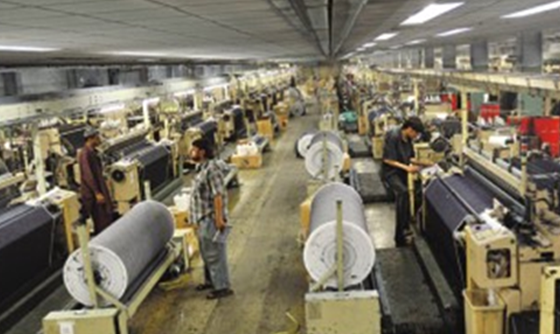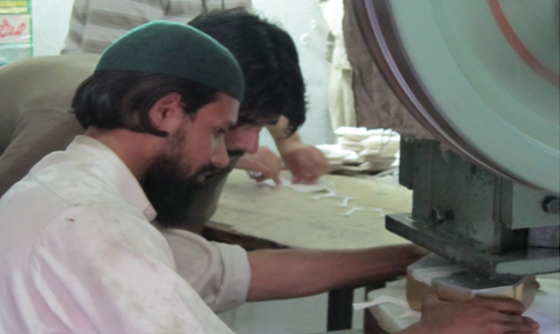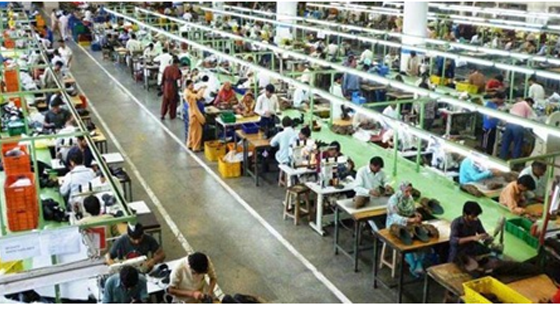 | Department of Economics |
Research Themes
Innovation and Technology
Barriers to Product Upgradation in the Sialkot Surgical Goods Sector
Researcher: Azam Chaudhry (Lahore School of Economics), Shamyla Chaudhary (Lahore School of Economics), Amit Khandelwal (Columbia University), Eric Verhoogen (Columbia University) and David Atkin (MIT)
The study investigates the extent to which fixed costs of innovation are a barrier to upgrading in the surgical-goods sector in Sialkot.
The project has been developed under the International Growth Centre (IGC) and the Private Enterprise in Developing Countries (PEDL) initiative. In this project, they investigate the extent to which fixed costs of innovation are a barrier to upgrading in the surgical-goods sector in Sialkot. If there are externalities in the process of innovation, there may be an important role for governments in subsidizing the costs of innovation. A leading policy idea is to provide matching grants, in which governments provide supplemental funding for projects chosen by individual firms. However, there has never been a rigorous randomized evaluation of such a program (Campos et al, 2012). They are conducting such an evaluation in the surgical-goods industry in Sialkot and plan to offer matching grants for innovations that increase exports.
The team aims to develop a randomized trial to incentivize firms to enter new product lines. We have developed a census of producers in the surgical goods sector in Sialkot using a short survey.
The team aims to launch the intervention by December 2018 and complete the follow up surveys by October 2020.
Barriers to Upgrading in the Sialkot Football Sector
Researcher: Azam Chaudhry (Lahore School of Economics), Shamyla Chaudhary (Lahore School of Economics), Amit Khandelwal (Columbia University), Eric Verhoogen (Columbia University) & David Atkin (MIT)
- The study seeks to investigate the extent to which high costs of high-quality inputs are a barrier to upgrading in the soccer-ball sector.
- The team offered subsidies for high-quality rexine (i.e. artificial leather and one of the primary inputs into soccer-ball production) to a random subset of firms. Since fall of 2016, we have collected firm-level data regularly to examine if this subsidy spurs upgrading.
- The end-line survey is due to take place in the summer of 2018.
The project has been developed under the International Growth Centre (IGC) and the Private Enterprise in Developing Countries (PEDL) initiative. In this project, the researchers investigate the extent to which high costs of high-quality inputs are a barrier to upgrading in the football sector. One of the primary inputs into football production is an artificial leather called rexine. They propose an experiment to offer subsidies for high-quality rexine to a random subset of firms and examine if this subsidy spurs upgrading. They will look at two related but distinct dimensions of behavioural responses by firms. First, since high-quality inputs are likely to be complements in production, the subsidy may induce firms to purchase complementary high-quality inputs and produce higher-quality footballs, using their existing technologies and production processes. Second, the subsidy may potentially stimulate learning and spur technological improvements in the production process, if for instance innovation has a higher return in high-quality segments of the industry or if producing higher-quality balls leads firms to transact with more knowledgeable buyers.
Understanding Institutional Barriers to Technology Adoption in the Pakistani Manufacturing Sector
Researcher: Matthew McCartney (University of Oxford), Theresa Chaudhry (Lahore School) and Azam Chaudhry (Lahore School)
Researchers plan to study the historical barriers to technology adoption in the Pakistani manufacturing sector with a special emphasis on institutional barriers like the conflict between workers and management, the impact of family run firms on organizational structures and the relationship between producers and suppliers in an uncertain business environment.
Innovation and firm performance in developing countries: The case of Pakistani textile and apparel manufacturers
Researcher: Waqar Wadho (Lahore School), Azam Chaudhry (Lahore School)

The project has been developed under the International Growth Centre (IGC). Innovation and competitiveness are considered to be the backbone of private sector led economic growth and its sustainability. However, in Pakistan, very little is known about the nature and the extent of innovation as well as its determinants and obstacles. In the absence of such evidence, policies can be misdirected and ineffective. In this project, the researchers surveyed a sample of 500 textile firms in Punjab and Sindh. The survey measured both the technological (product and process) and the non-technological (organizational and marketing) aspects of innovation where an innovation is the introduction of a new or significantly improved product, process, organizational method, or marketing method by an enterprise. Through this survey, the researchers measure 'innovation' in at least four different ways: (1) Innovation rate (based on the response of enterprise if they had innovated during 2011-13, which is further be divided into four types of innovation; i.e. product, process, organizational and marketing), (2) Innovation input (given by the ratio of R&D expenditure to sales), (3) Innovation output (given by the ratio of new products sales to total sales), and (4) Innovation efficiency (given by the ratio of new product sales to R&D expenditure).
Through this study, the researchers answers the following research questions:
- How innovative is the textiles sector of Pakistan (measured in four different ways as described above)?
- What are the correlates (both in terms of promoting and hampering) of innovation? (such as firm type and size, market structure, product market i.e. local or international, government regulations and facilitations, sources and type of cooperation, management patterns, skill profile, ICT, access to finance and source of finances, information on technology and markets, and demand for innovations etc.).
Using unique innovation survey data collected from a homogenous sample of firms in Pakistan, this paper presents an analysis of the firm level determinants of product innovation and its impact on firm performance. We employ a multi-stage structural model linking the decision of a firm to innovate, its innovation investment, product innovation, and firm performance using primary data from the textile and wearing apparel sector, which is the largest export sector of Pakistan. We find that product innovation leads to increased labor productivity as well as higher labor productivity growth. A 10 percent increase in innovative sales per worker is associated with a greater than 10 percent increase in labor productivity and labor productivity growth. On the determinants of innovation, we find that vertical knowledge flows from foreign clients and suppliers are important determinants of a firm's decision to innovate. Larger firms are more likely to engage in innovation, however, there is no significant evidence that they invest more in innovation. Exporting is positively associated with innovation performance and firms exporting to Europe and America are more likely to engage in innovation. There is mixed evidence on the impact of competition: foreign competition adversely affects a firm's decision to innovate, whereas, local competition increases investment in innovation. Subsidies seem to have a crowding out effect since firms receiving national subsides invest less in innovation. Furthermore, firms that have higher investment in innovation, that are more productive, and that introduce organizational innovations have higher innovative sales per worker.
Published in Research Policy in 2018, Volume 47, Issue 7, Pages 1283-1294.
Analysis of Technology in the Sialkot Soccer Ball industry
Researcher: Azam Chaudhry (Department of Economics, Lahore School), Shamyla Chaudry (Department of Economics, Lahore School), Eric Verhoogen (Department of Economics, Columbia University), Amit K. Khandewal (Graduate School of Business, Columbia University) and David Atkins (Department of Economics, MIT)

The project has been developed under the International Growth Centre (IGC) and the Private Enterprise in Developing Countries (PEDL) initiative. The Sialkot soccer ball cluster is made up of a large number of manufactures who export approximately 60 million hand-stitched soccer balls each year, accounting for about 70 percent of global production. But over the last few years, the amount of soccer balls produced in Sialkot has fallen. This project aims to better understand the technologies within the industry and determine the characteristics of the firms that are able to identify and implement new technologies.
The research team developed a cost saving technology in 2012 which it has given to a number of soccer ball manufacturers in Pakistan in order to determine the factors affecting technology adoption in firms and technology spillovers between firms. The research team has also looked at how misaligned incentives between firms and employees can affect technology adoption. The preliminary data analysis was presented at the IGC Growth Week in September 2012 and September 2013 in London. The researchers have presented this work in seminars and conferences at University of Berkley, Yale University, Columbia University, Harvard University and University of Oxford. It has also been presented at the Government of Punjab in 2015. After these presentations the Secretary Finance and the Secretary Industries, Punjab Government used the project's findings to propose and initiate an Innovation Development Fund (IDF). Currently, the Punjab Government has initiated this fund and the Lahore School is represented on its executive board. The findings of this project have been published in:
Published Article: Atkin, A., Chaudhry, A., Chaudry, S., Khandelwal, A. K and Verhoogan, E. "Organizational Barriers to Technology Adoption: Evidence from Soccer-Ball Producers in Pakistan". Quarterly Journal of Economics (2017)
Published Article: Atkin, A., Chaudhry, A., Chaudry, S., Khandelwal, A. K., Raza, T., and Verhoogan, E. "On the Origins and Development of Pakistan's Soccer-Ball Cluster". World Bank Economic Review (2016)
Published Article: Atkin, A., Chaudhry, A., Chaudry, S., Khandelwal, A. K and Verhoogan, E. "Markup and Cost Dispersion across Firms: Direct Evidence from Producer Surveys in Pakistan". American Economic Review, Papers and Proceedings (2015).
Technology and Innovation Mapping Project
Researcher: Azam Chaudhry (Lahore School), Theresa Chaudhry (Lahore School) and Mahvish Faran (Lahore School; PhD. candidate, Sheffield University)
The aim of this initiative is to map the production process and the technologies used in the soccer ball and readymade garments sector. Then using this map, compare the technologies in these sectors with the forefront of international technologies to see how far behind firms in Pakistan are. Finally, the research team will see what incentives can be given to Pakistani firms to adopt new technologies (like financial incentives, supplying information about these technologies, providing assistance of adoption of these new technologies, etc.).
Collaborators include Rajah Rasiah (University of Malaya).

Innovation in the Textiles Sector: A Firm-Level Analysis of Technological and Nontechnological Innovation
Researcher: Waqar Wadho (Lahore School) and Azam Chaudhry (Lahore School)
In a knowledge-based economy, it has become increasingly important to better understand critical aspects of the innovation process such as innovation activities beyond R&D, the interaction among different actors in the market and the relevant knowledge flows.
Using a sample of 431 textiles and apparel manufacturers, this paper explores the dynamics of firms' innovation activities by analyzing their innovation behavior, the extent and types of innovation, the resources devoted to innovation, sources of knowledge spillovers, the factors hampering technological innovation and the returns to innovation for three years, 2013-15.
Our results show that 56 percent of the surveyed firms introduced technological and/or nontechnological innovations, while 38 percent introduced new products, these innovations were generally incremental as the majority of innovations were new only to the firm. Furthermore, the innovation rate increases with firm size; large firms have an innovation rate of 83 percent, followed by medium firms (68 percent) and small firms (39 percent). Technologically innovative firms spent, on average, 10 percent of their turnover on innovation expenditure in 2015. Acquisition of machinery and equipment is the main innovation activity, accounting for 56 percent of innovation expenditures. Large firms consider foreign market sources (clients and suppliers) and small firms consider local market sources their key source of information and cooperation. 63 percent of technological innovators cite improving the quality of goods as their most important objective. Lack of available funds within the enterprise is the single most important cost factor hampering innovation, followed by the high cost of innovation. Our results show that 67 percent of the turnover among product innovators in 2015 resulted from product innovations that were either new to the market or new to the firm.
Published Article: The Lahore Journal of Economics, Volume 21: SE (September 2016): pp. 129-166.
| RESEARCH |
 People
People